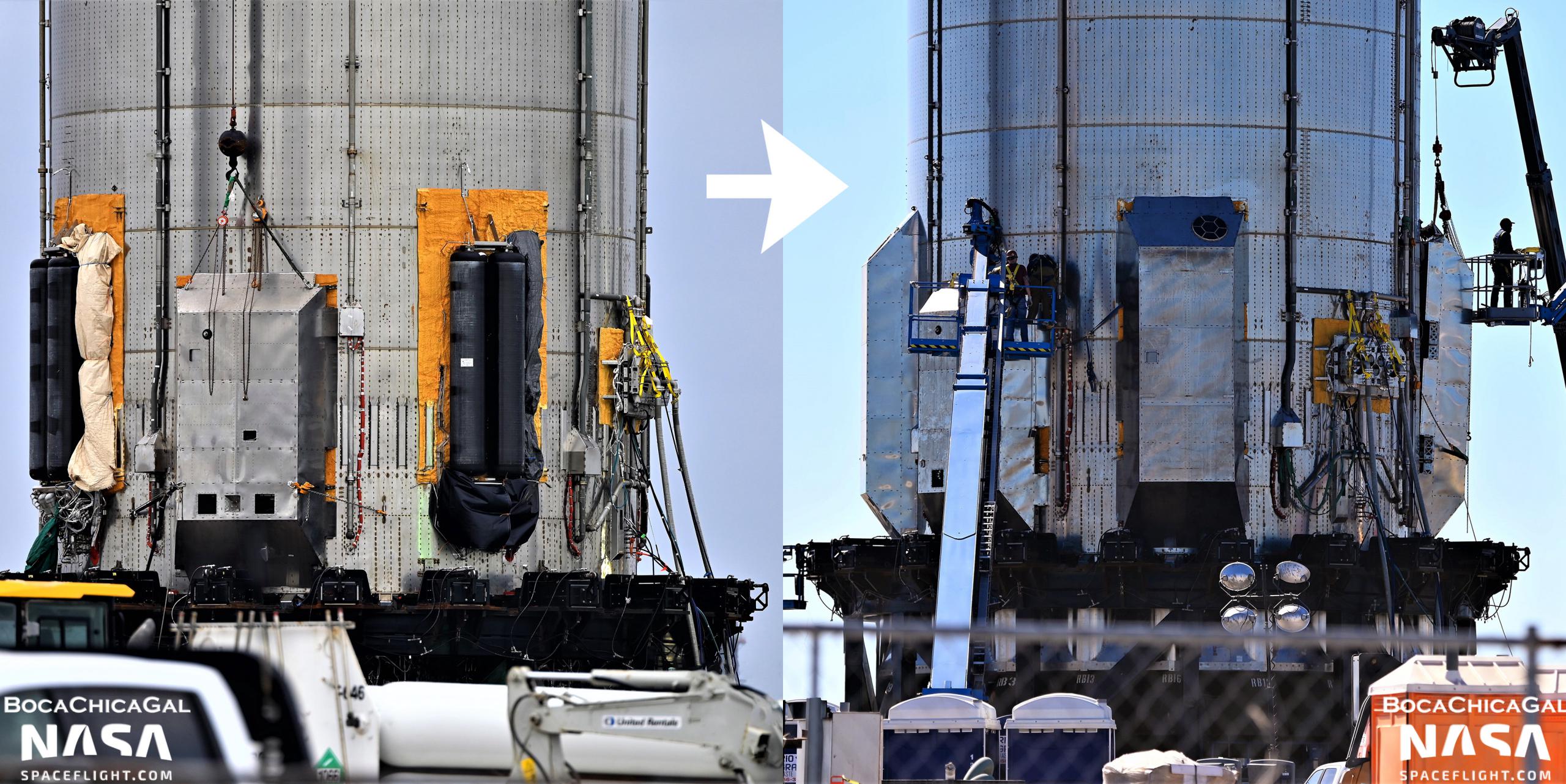

SpaceX
SpaceX fully installs Super Heavy booster’s ‘aerocovers’
For the first time, SpaceX has more or less installed a full set of ‘aerocovers’ on a Super Heavy booster prototype.
Designed to protect the booster from both itself and Earth’s atmosphere during ground testing, liftoff, ascent, and reentry, Super Heavy’s the structures amount to thin, steel shells mounted on metal box frames. The most obvious aerocovers slot over the top of six racks of equipment installed on the outside of Super Heavy’s aft end, giving the booster a sort of utility belt of hydraulic systems, pressure vessels, avionics, and heat exchangers. Unsurprisingly, those racks are festooned with electronics, composites, and thousands of feet of wiring and thin plumbing – none of which are particularly suited to sit a few dozen feet from the fury of 29-33 Raptor engines or near the leading edge of a hypersonic reentry vehicle.
Aside from the steel they’re mounted on, it’s likely that every system located on Super Heavy’s ‘utility built’ would begin malfunctioning or be destroyed outright if directly exposed to just a few seconds of the hypersonic buffeting and heating Starship boosters will experience during reentry. Unlike Falcon boosters, which almost always use reentry burns to slow down and create a sort of heat shield with their own exhaust, SpaceX is theoretically designing Super Heavy to survive the full force of reentry without an extra burn to cushion the blow.
To survive reentry and still land in good enough condition to enable anything close to same-day reusability, which is SpaceX’s goal, every ounce of at-risk equipment installed on Super Heavy’s exterior will likely need to be carefully shielded. In theory, that’s the purpose of the aerocovers SpaceX has only just begun to fully install – let alone test – on Super Heavy B4.
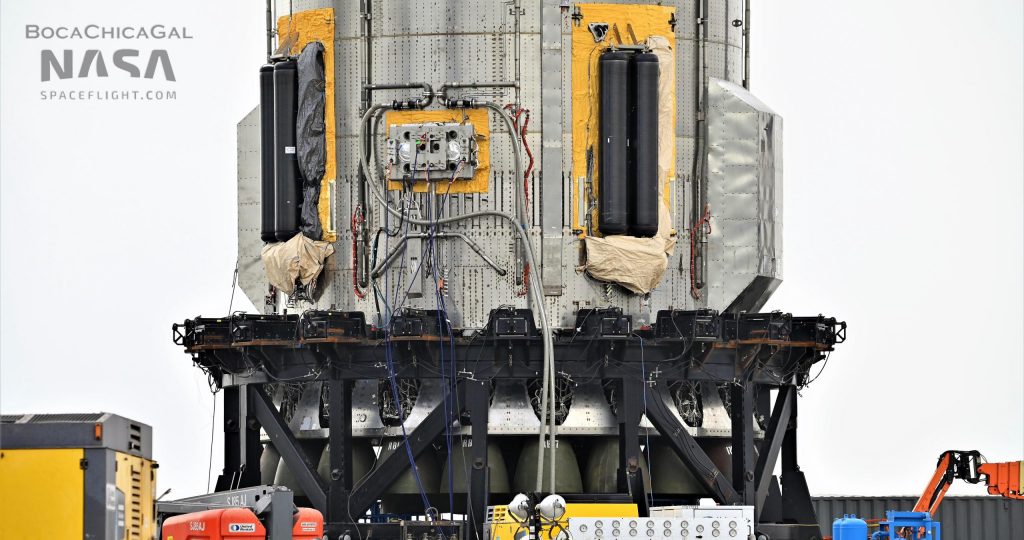
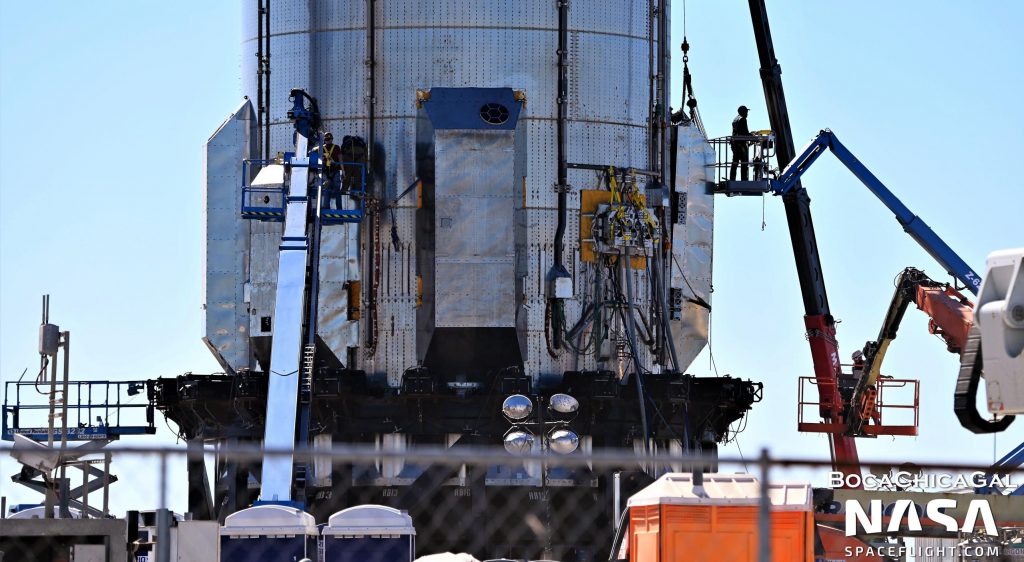
Before Booster 4’s most recent installation on the orbital launch mount, SpaceX did install covers over a pair of hydraulic and heat exchanger racks but left all four composite overwrapped pressure vessel (COPV) racks and an umbilical port uncovered. After B4 was removed from the launch mount for the third time on December 30th, both covers were uninstalled. On January 14th, 2022, though, SpaceX rapidly installed all six covers for the first time and began sealing each cover’s exposed corners. On January 17th, SpaceX even installed aerodynamic surfaces around Booster 4’s protruding umbilical port, smoothing out any hypothetical airflow around the device.
Prior to main aerocover installation, SpaceX also added at least half a dozen small boxes seemingly designed to protect a number of thin metal probes that pierce through Super Heavy’s tanks and skin and are connected to avionics boxes. Additionally, while less visible, teams also worked to finish Super Heavy B4’s Raptor heat shielding with a large number of similar sheet steel covers and panels. Without official photos from SpaceX or another lift onto the launch mount, it’s impossible to know if Booster 4’s Raptor heat shield is fully closed out, but the shielding that runs around its circumference appears to be finished.
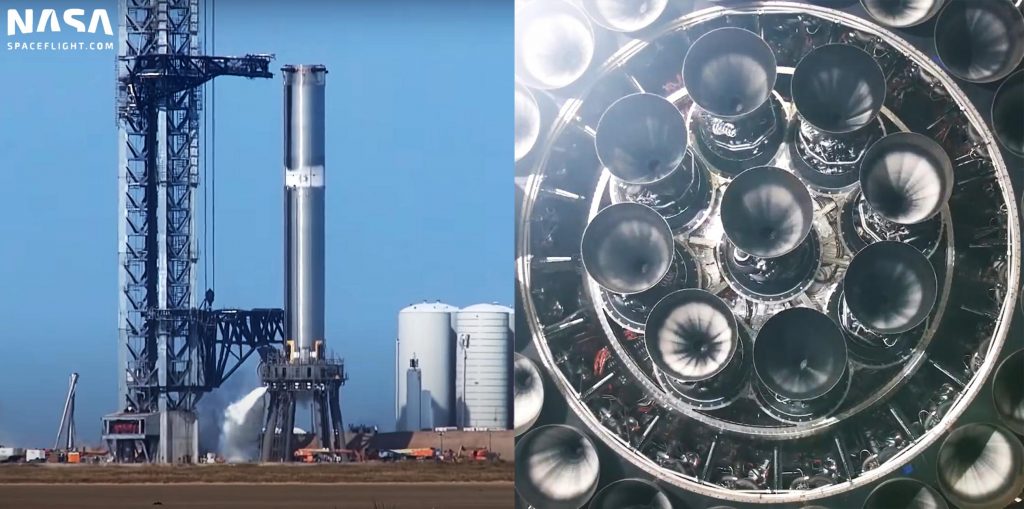
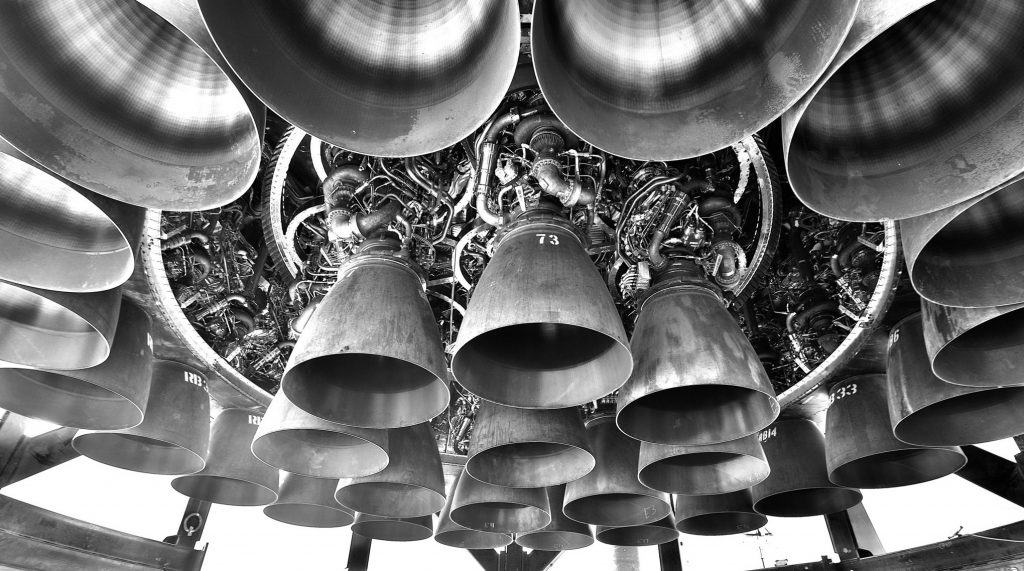
As it stands, Super Heavy B4 is likely just a few parts shy of true completion and is about as ready as it’ll ever be for static fire testing. More likely than not, those aerocovers and Raptor heat shields are essential for Super Heavy B4 to be able to perform more than one test at a time without immediately requiring major repairs. Unlike Starship, which has mostly tested three engines at once and only performed a few six-engine static fires, Super Heavy B4 may eventually test all 29 Raptor engines simultaneously.
When almost 30 engines are involved, even nominal preburner testing will likely produce a massive fireball that could engulf Super Heavy’s aft (if not the entire booster) with flames. For static fire testing, Raptors typically produce a smaller and briefer (but still substantial) fireball during shutdown, creating another potential source of damage to any sensitive hardware located anywhere on or in Booster 4’s thrust section. As such, Super Heavy aerocovers may be just as important for surviving static fires as they’ll be for surviving launches and landings.
It’s unclear if or when Super Heavy B4 will return to the orbital launch mount for wet dress rehearsal and static fire testing. SpaceX has ambiguous test windows scheduled from 10am to 10pm on January 18th, 19th, and 20th.
News
SpaceX launches Ax-4 mission to the ISS with international crew
The SpaceX Falcon 9 launched Axiom’s Ax-4 mission to ISS. Ax-4 crew will conduct 60+ science experiments during a 14-day stay on the ISS.
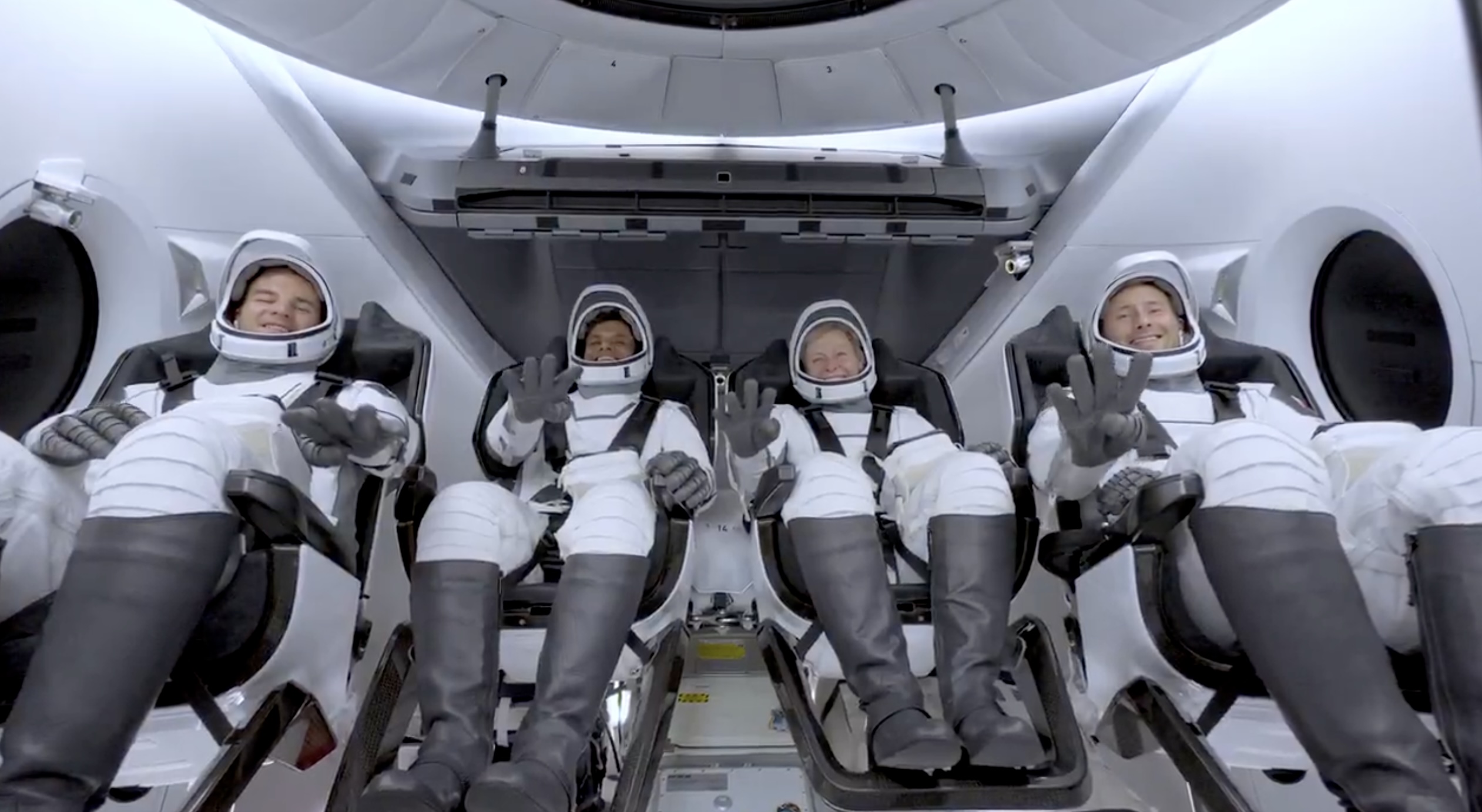
SpaceX launched the Falcon 9 rocket kickstarting Axiom Space’s Ax-4 mission to the International Space Station (ISS). Axiom’s Ax-4 mission is led by a historic international crew and lifted off from Kennedy Space Center’s Launch Complex 39A at 2:31 a.m. ET on June 25, 2025.
The Ax-4 crew is set to dock with the ISS around 7 a.m. ET on Thursday, June 26, 2025. Axiom Space, a Houston-based commercial space company, coordinated the mission with SpaceX for transportation and NASA for ISS access, with support from the European Space Agency and the astronauts’ governments.
The Ax-4 mission marks a milestone in global space collaboration. The Ax-4 crew, commanded by U.S. astronaut Peggy Whitson, includes Shubhanshu Shukla from India as the pilot, alongside mission specialists Sławosz Uznański-Wiśniewski from Poland and Tibor Kapu from Hungary.
“The trip marks the return to human spaceflight for those countries — their first government-sponsored flights in more than 40 years,” Axiom noted.
Shukla’s participation aligns with India’s Gaganyaan program planned for 2027. He is the first Indian astronaut to visit the ISS since Rakesh Sharma in 1984.
Axiom’s Ax-4 mission marks SpaceX’s 18th human spaceflight. The mission employs a Crew Dragon capsule atop a Falcon 9 rocket, designed with a launch escape system and “two-fault tolerant” for enhanced safety. The Axiom mission faced a few delays due to weather, a Falcon 9 leak, and an ISS Zvezda module leak investigation by NASA and Roscosmos before the recent successful launch.
As the crew prepares to execute its scientific objectives, SpaceX’s Ax-4 mission paves the way for a new era of inclusive space research, inspiring future generations and solidifying collaborative ties in the cosmos. During the Ax-4 crew’s 14-day stay in the ISS, the astronauts will conduct nearly 60 experiments.
“We’ll be conducting research that spans biology, material, and physical sciences as well as technology demonstrations,” said Whitson. “We’ll also be engaging with students around the world, sharing our experience and inspiring the next generation of explorers.”
SpaceX’s Ax-4 mission highlights Axiom’s role in advancing commercial spaceflight and fostering international partnerships. The mission strengthens global space exploration efforts by enabling historic spaceflight returns for India, Poland, and Hungary.
News
Starlink Cellular’s T-Mobile service to grow with third-party app data
From Oct 2025, T-Satellite will enable third-party apps in dead zones! WhatsApp, X, AccuWeather + more coming soon.

Starlink Cellular’s T-Mobile service will expand with third-party app data support starting in October, enhancing connectivity in cellular dead zones.
T-Mobile’s T-Satellite, supported by Starlink, launches officially on July 23. Following its launch, T-Mobile’s Starlink Cellular service will enable data access for third-party apps like WhatsApp, X, Google, Apple, AccuWeather, and AllTrails on October 1, 2025.
T-Mobile’s Starlink Cellular is currently in free beta. T-Satellite will add MMS support for Android phones on July 23, with iPhone support to follow. MMS support allows users to send images and audio clips alongside texts. By October, T-Mobile will extend emergency texting to all mobile users with compatible phones, beyond just T-Mobile customers, building on its existing 911 texting capability. The carrier also provides developer tools to help app makers integrate their software with T-Satellite’s data service, with plans to grow the supported app list.
T-Mobile announced these updates during an event celebrating an Ookla award naming it the best U.S. phone network, a remarkable turnaround from its last-place ranking a decade ago.
“We not only dream about going from worst to best, we actually do it. We’re a good two years ahead of Verizon and AT&T, and I believe that lead is going to grow,” said T-Mobile’s Chief Operating Officer Srini Gopalan.
T-Mobile unveiled two promotions for its Starlink Cellular services to attract new subscribers. A free DoorDash DashPass membership, valued at $10/month, will be included with popular plans like Experience Beyond and Experience More, offering reduced delivery and service fees. Meanwhile, the Easy Upgrade promotion targets Verizon customers by paying off their phone balances and providing flagship devices like the iPhone 16, Galaxy S25, or Pixel 9.
T-Mobile’s collaboration with SpaceX’s Starlink Cellular leverages orbiting satellites to deliver connectivity where traditional networks fail, particularly in remote areas. Supporting third-party apps underscores T-Mobile’s commitment to enhancing user experiences through innovative partnerships. As T-Satellite’s capabilities grow, including broader app integration and emergency access, T-Mobile is poised to strengthen its lead in the U.S. wireless market.
By combining Starlink’s satellite technology with strategic promotions, T-Mobile is redefining mobile connectivity. The upcoming third-party app data support and official T-Satellite launch mark a significant step toward seamless communication, positioning T-Mobile as a trailblazer in next-generation wireless services.
News
Starlink expansion into Vietnam targets the healthcare sector
Starlink aims to deliver reliable internet to Vietnam’s remote clinics, enabling telehealth and data sharing.

SpaceX’s Starlink expansion into Vietnam targets its healthcare sector. Through Starlink, SpaceX seeks to drive digital transformation in Vietnam.
On June 18, a SpaceX delegation met with Vietnam’s Ministry of Health (MoH) in Hanoi. SpaceX’s delegation was led by Andrew Matlock, Director of Enterprise Sales, and the discussions focused on enhancing connectivity for hospitals and clinics in Vietnam’s remote areas.
Deputy Minister of Health (MoH) Tran Van Thuan emphasized collaboration between SpaceX and Vietnam. Tran stated: “SpaceX should cooperate with the MoH to ensure all hospitals and clinics in remote areas are connected to the StarLink satellite system and share information, plans, and the issues discussed by members of the MoH. The ministry is also ready to provide information and send staff to work with the corporation.”
The MoH assigned its Department of Science, Technology, and Training to work with SpaceX. Starlink Vietnam will also receive support from Vietnam’s Department of International Cooperation. Starlink Vietnam’s agenda includes improving internet connectivity for remote healthcare facilities, developing digital infrastructure for health examinations and remote consultations, and enhancing operational systems.
Vietnam’s health sector is prioritizing IT and digital transformation, focusing on electronic health records, data centers, and remote medical services. However, challenges persist in deploying IT solutions in remote regions, prompting Vietnam to seek partnerships like SpaceX’s.
SpaceX’s Starlink has a proven track record in healthcare. In Rwanda, its services supported 40 health centers, earning praise for improving operations. Similarly, Starlink enabled remote consultations at the UAE’s Emirati field hospital in Gaza, streamlining communication for complex medical cases. These successes highlight Starlink’s potential to transform Vietnam’s healthcare landscape.
On May 20, SpaceX met with Vietnam’s Ministry of Industry and Trade, announcing a $1.5 billion investment to provide broadband internet, particularly in remote, border, and island areas. The first phase includes building 10-15 ground stations across the country. This infrastructure will support Starlink’s healthcare initiatives by ensuring reliable connectivity.
Starlink’s expansion in Vietnam aligns with the country’s push for digital transformation, as outlined by the MoH. By leveraging its satellite internet expertise, SpaceX aims to bridge connectivity gaps, enabling advanced healthcare services in underserved regions. This collaboration could redefine Vietnam’s healthcare infrastructure, positioning Starlink as a key player in the nation’s digital future.
-

 News5 days ago
News5 days agoTesla Robotaxi’s biggest challenge seems to be this one thing
-

 News2 weeks ago
News2 weeks agoTesla confirms massive hardware change for autonomy improvement
-

 Elon Musk2 weeks ago
Elon Musk2 weeks agoElon Musk slams Bloomberg’s shocking xAI cash burn claims
-

 News2 weeks ago
News2 weeks agoTesla features used to flunk 16-year-old’s driver license test
-

 News2 weeks ago
News2 weeks agoTesla China roars back with highest vehicle registrations this Q2 so far
-

 News2 weeks ago
News2 weeks agoTexas lawmakers urge Tesla to delay Austin robotaxi launch to September
-

 News2 weeks ago
News2 weeks agoTesla dominates Cars.com’s Made in America Index with clean sweep
-

 News2 weeks ago
News2 weeks agoTesla’s Grok integration will be more realistic with this cool feature





















